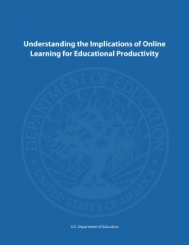Promoting Grit, Tenacity, and Perseverance - U.S. Department of ...
Promoting Grit, Tenacity, and Perseverance - U.S. Department of ...
Promoting Grit, Tenacity, and Perseverance - U.S. Department of ...
You also want an ePaper? Increase the reach of your titles
YUMPU automatically turns print PDFs into web optimized ePapers that Google loves.
Draft<br />
Some example measures. Teacher report emerged in our interviews as an important method for<br />
measuring constructs around grit, tenacity, <strong>and</strong> perseverance. For example, KIPP <strong>and</strong> other<br />
character education programs have been developing methods <strong>of</strong> using explicit teacher feedback<br />
to help students gauge their level <strong>of</strong> grit with respect to specific criteria <strong>and</strong> to open up<br />
conversations among parents, teachers, <strong>and</strong> students (see Chapter 4 for more details about these<br />
models). These schools have been implementing a “Character Report Card” on which students<br />
receive ratings pooled from multiple teachers on factors such as grit <strong>and</strong> self-control. Exhibit 9<br />
illustrates what such a report card might look like. It is important that these ratings come from<br />
multiple teachers, as they are then less susceptible to biases <strong>of</strong> particular relationships. KIPP has<br />
been facilitating the use <strong>of</strong> these Report Cards with a technology called PowerTeacher that<br />
allows teachers to input their ratings online. Informant reporting is also a common approach for<br />
teachers, parents/guardians, <strong>and</strong> mental health pr<strong>of</strong>essionals to assess the social-emotional<br />
competencies that serve as protective factors associated with resilience in young children. For<br />
example, the Devereux Student Strengths Assessment (DESSA; LeBuffe, Shapiro & Naglieri,<br />
2009) can be used for children in kindergarten through eighth grade (ages 5-‐14). The DESSA is a<br />
72-‐item, st<strong>and</strong>ardized, norm-‐referenced behavior rating scale that focuses on student strengths<br />
<strong>and</strong> positive behaviors related to eight dimensions: self-‐awareness, social awareness, self-management,<br />
goal-‐directed behavior, relationship skills, personal responsibility, decision<br />
making, <strong>and</strong> optimistic thinking. It can be used for screening, pr<strong>of</strong>iling for intervention, <strong>and</strong><br />
monitoring <strong>and</strong> measuring change (Hall, 2010).<br />
While we did not find classroom observation protocols that measure grit, tenacity, or<br />
perseverance per se for individual students, there are protocols that measure related constructs,<br />
such as engagement. An example <strong>of</strong> a validated classroom observation protocol targeting<br />
students’ engagement is presented by Skinner, Kindermann, <strong>and</strong> Furrer (2009). This protocol<br />
examines elementary school students’ behavior, characterizing it as actively on-task, passively<br />
on-task, or <strong>of</strong>f-task. Such a measure could be used during challenging tasks to examine students’<br />
perseverance.<br />
38
















